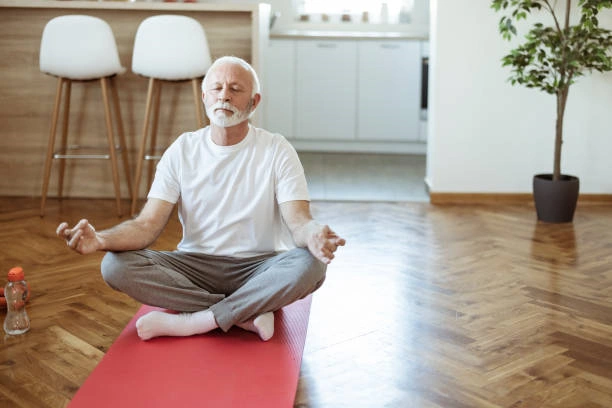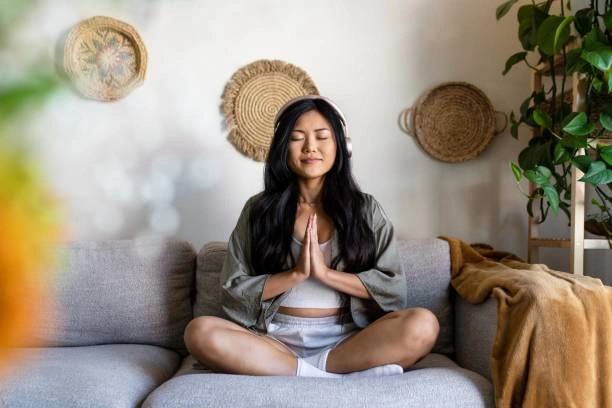Methods for Practicing Mindfulness Meditation
The core of mindfulness meditation practice is seated meditation, which typically consists of three parts: relaxation meditation, concentration meditation, and mindfulness meditation. Choose a quiet time and place to meditate. The length of your meditation is entirely up to you, but it’s recommended to pick a time when your mind is relatively alert, as you are working to cultivate awareness. You can sit on a chair or a cushion, with your back straight and hands resting on your knees.
01. Relaxation Meditation
Remember, the goal of mindfulness meditation is to practice mindfulness. In other words, we aim to observe ourselves objectively. However, if our minds are chaotic or our bodies are tense, achieving a calm state isn’t guaranteed. That’s why we typically start meditation with a brief relaxation exercise: before closing your eyes, give your body a moment to adjust. Take a deep breath in, then exhale through your mouth, making a sound like “whoosh” or “ha.” Repeat this three times to prepare your body for meditation. Then, close your eyes and start following your breath. After a few minutes, shift your attention to your body, starting from the top of your head. As you gradually move your attention through your body, consciously relax each muscle during exhalation. This relaxation meditation should last about five minutes.
02. Concentration Meditation
The next part of mindfulness meditation is concentration meditation. If we want to observe something on a deeper level, we need to maintain focus on it. Concentration meditation helps you develop mental “discipline.” If you’re easily distracted, your observation will only be superficial. Concentration meditation helps stabilize your thoughts, allowing you to observe things more deeply. This process is essential for developing a deeper understanding.
To practice concentration meditation, begin by silently counting your breaths from one to five. When you reach five, start over. Focus on the sensation of air passing through your nostrils. If you notice your thoughts wandering, immediately bring your attention back to your breath.
Concentration meditation may be challenging, but it’s important to do your best to keep your attention on your focal point. It’s normal for your thoughts to wander. Keep focusing on the breath through your nose. With practice, it will become easier.

03. Mindfulness Meditation
After completing relaxation and concentration meditation, you’re ready for mindfulness meditation. Relaxation meditation helps calm your body and mind, while concentration meditation helps you focus, allowing for deeper observation.
Remember, mindfulness meditation practice is a form of mental training. We are training our minds to see more clearly and then applying these enhanced observation skills in daily life. It’s similar to physical exercise; after a period of training, we can perform better in actual situations.
At this stage, you can stop counting and observe the entire breathing process more naturally. Watch it in a relaxed way, without forcing your thoughts like in concentration meditation. When distractions arise, gently bring your attention back to your breath.
04. Emotional Awareness Meditation
An alternative approach to mindfulness meditation is emotional awareness meditation, where you train yourself to observe your emotions. Over time, this type of meditation will help you gain more control over your emotions and develop greater inner strength.
To practice emotional awareness meditation, first do relaxation and concentration meditation. After completing concentration meditation, shift your attention to your emotions. Ask yourself questions such as, “What am I feeling?” “Am I experiencing joy, sadness, anger, loneliness, hurt, irritation, boredom, or other emotions?” Simply focus on identifying the emotions, and if you feel ready, explore them more deeply. Look at the thoughts behind them, and try to view the situation from a broader perspective.

05. Walking Meditation
If you feel restless during seated meditation, walking meditation is another way to calm your mind. Practicing walking meditation is simple. It’s best done in a quiet, scenic place. Walk at a much slower pace than usual, using the same method of focusing, but instead of concentrating on your breath, focus on your steps. Alternatively, you can focus on your entire body while walking, noticing each movement. A variation of walking meditation is mindful walking. The techniques are the same, but rather than meditating while walking, practice mindful walking during everyday activities. For example, when walking at work, at home, or anywhere else, walk consciously without making phone calls or letting your thoughts wander aimlessly.
06. Mindful Activities
You can turn any activity into mindfulness meditation. Choose an activity that doesn’t require much attention, like washing dishes or folding clothes. These types of tasks are usually routine and done without much thought, but now you can use them to help develop mindfulness. Perform the activity mindfully by first slowing down. Don’t rush to complete it as you normally would. Pay close attention to every movement. For example, when folding clothes, be aware of how you fold them, their smell, and texture. You might even want to fold them a little more neatly than usual.
The great thing about mindfulness meditation practice is its flexibility. There are various techniques that can be combined to fit your lifestyle and busy schedule. If you’re new, start with 5-10 minutes of seated meditation—sitting quietly and practicing relaxation, concentration, and mindfulness meditation. Gradually increase the duration to 20 minutes or more. Over time, you’ll become more perceptive, and everything around you will become clearer. You’ll not only see things on a deeper level but also start to understand how everything is interconnected. When this happens, the world will appear fresh and exciting again—this is enlightenment.




